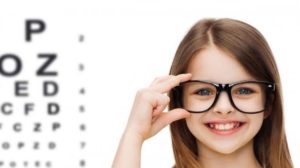#1 Look out for patterns of behavior
The first tell-tale sign that your child may be suffering from poor eyesight is if they regularly sit in front of the television, or if they squint their eyes when trying to read something, regardless of distance. According to our research, only 65% of adults are actually aware that these two behaviors could be a sign that their child needs an eye doctor.
If you notice your child behaving this way, get in touch with their school to check if the school offers an eye examination program, only 24% of parents who participated in our research said that their schools offer programmes such as this, so don’t depend on the school to organize eye examinations, get in touch with your local optician!
#2 Listen to your children
According to 96% of optometrists, having a clear vision can have huge positive impacts on a child’s learning. So, if you hear your kids complaining that they cannot see clearly, or are struggling to read something, listen to them. Ask other questions to see if you can initially identify any clear signs that they may be struggling with their vision.
If your child is struggling to clearly see their schoolwork, this could negatively impact their motivation to learn. A free NHS eye examination will accurately check your child’s vision and eye health. Check with your local optician to see what options are available for your family.
#3 Monitor their progress at school
Receiving disappointing grades from a piece of school work is upsetting for any child. Especially so if poor eyesight is a contributing factor. Don’t wait until you hear from a teacher that they think your child might be struggling, if your child has expressed difficulties about not being able to clearly see the whiteboard, it is time they got their eyes tested.
Exclude all possibilities that your child’s schoolwork is not meeting predicted grades due to poor eyesight by taking your child to get their eyes tested. Eye examinations will identify your child’s overall eye health, and if they are developing any eye conditions such as short-sightedness (myopia) or a lazy eye (amblyopia).
#4 Enrol them at your local opticians
Enrolling your child at your local opticians can take a matter of minutes. Most opticians will have online enrolment forms however, you can often enroll over the phone or simply visit a branch. It is recommended that children start having eye examinations from the age of four or five years old. Having regular tests from this age will determine any eye conditions, related to long-sightedness or short-sightedness as early as possible, meaning your children can get the right help and support they need to confidently continue with their learning.
Children whose parents have eye conditions, such as myopia, are three times more likely to be affected by the same condition than those parents who do not suffer from short-sightedness. Enrolling your child at the first opportunity eliminates any waiting time that may occur to complete the enrolment. This means as soon as your child shows any sign of poor eye-sight you can give them the support they need without any delay.
If you’re concerned about your child’s vision, contact our dedicated eye health specialists on 09599229744 and see how we can help you.


Leave a Reply